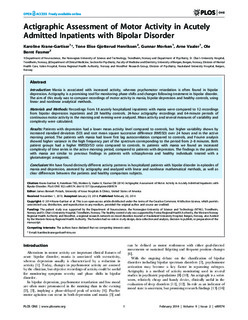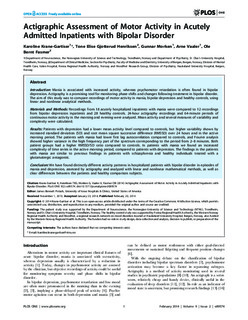| dc.contributor.author | Krane-Gartiser, Karoline | |
| dc.contributor.author | Henriksen, Tone Elise Gjøtterud | |
| dc.contributor.author | Morken, Gunnar | |
| dc.contributor.author | Vaaler, Arne Einar | |
| dc.contributor.author | Fasmer, Ole Bernt | |
| dc.date.accessioned | 2015-03-03T16:01:31Z | |
| dc.date.accessioned | 2015-08-12T12:43:32Z | |
| dc.date.available | 2015-03-03T16:01:31Z | |
| dc.date.available | 2015-08-12T12:43:32Z | |
| dc.date.issued | 2014 | |
| dc.identifier.citation | PLoS ONE 2014, 9(2) | nb_NO |
| dc.identifier.issn | 1932-6203 | |
| dc.identifier.uri | http://hdl.handle.net/11250/296391 | |
| dc.description.abstract | Introduction: Mania is associated with increased activity, whereas psychomotor retardation is often found in bipolar
depression. Actigraphy is a promising tool for monitoring phase shifts and changes following treatment in bipolar disorder.
The aim of this study was to compare recordings of motor activity in mania, bipolar depression and healthy controls, using
linear and nonlinear analytical methods.
Materials and Methods: Recordings from 18 acutely hospitalized inpatients with mania were compared to 12 recordings
from bipolar depression inpatients and 28 healthy controls. 24-hour actigraphy recordings and 64-minute periods of
continuous motor activity in the morning and evening were analyzed. Mean activity and several measures of variability and
complexity were calculated.
Results: Patients with depression had a lower mean activity level compared to controls, but higher variability shown by
increased standard deviation (SD) and root mean square successive difference (RMSSD) over 24 hours and in the active
morning period. The patients with mania had lower first lag autocorrelation compared to controls, and Fourier analysis
showed higher variance in the high frequency part of the spectrum corresponding to the period from 2–8 minutes. Both
patient groups had a higher RMSSD/SD ratio compared to controls. In patients with mania we found an increased
complexity of time series in the active morning period, compared to patients with depression. The findings in the patients
with mania are similar to previous findings in patients with schizophrenia and healthy individuals treated with a
glutamatergic antagonist.
Conclusion: We have found distinctly different activity patterns in hospitalized patients with bipolar disorder in episodes of
mania and depression, assessed by actigraphy and analyzed with linear and nonlinear mathematical methods, as well as
clear differences between the patients and healthy comparison subjects. | nb_NO |
| dc.language.iso | eng | nb_NO |
| dc.publisher | Public Library of Science | nb_NO |
| dc.title | Actigraphic assessment of motor activity in acutely admitted inpatients with bipolar disorder | nb_NO |
| dc.type | Journal article | nb_NO |
| dc.type | Peer reviewed | en_GB |
| dc.date.updated | 2015-03-03T16:01:30Z | |
| dc.subject.nsi | VDP::Medisinske fag: 700::Klinisk medisinske fag: 750::Nevrologi: 752 | nb_NO |
| dc.subject.nsi | VDP::Midical sciences: 700::Clinical medical sciences: 750::Neurology: 752 | nb_NO |
| dc.subject.nsi | VDP::Medisinske fag: 700::Klinisk medisinske fag: 750::Psykiatri, barnepsykiatri: 757 | nb_NO |
| dc.subject.nsi | VDP::Midical sciences: 700::Clinical medical sciences: 750::Psychiatry, child psychiatry: 757 | nb_NO |
| dc.source.volume | 9 | nb_NO |
| dc.source.journal | PLoS ONE | nb_NO |
| dc.source.issue | 2 | nb_NO |
| dc.identifier.doi | 10.1371/journal.pone.0089574 | |
| dc.identifier.cristin | 1124471 | |
| dc.description.localcode | (c) 2014 Krane-Gartiser et al. This is an open-access article distributed under the terms of the Creative Commons Attribution License, which permits unrestricted use, distribution, and reproduction in any medium, provided the original author and source are credited. | nb_NO |

